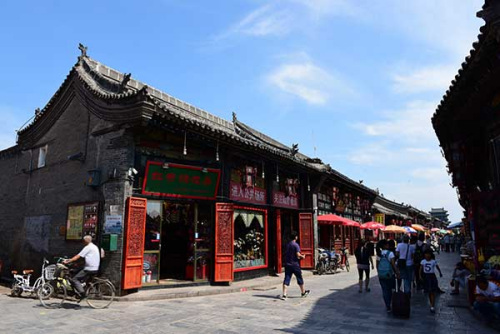
(Photo by Deepankar Aron/For chinadaily.com.cn)
Shanxi province is home to ancient architectural structures, stunning natural landscapes, important places of religious worship and three UNESCO world heritage sites. It looks back at a history of over 5,000 years and welcomes the present with amiable openness. It is truly a province with magical charm.
While expanding business sectors are gradually changing the cityscapes into metropolitan areas of international standards, the calmer side of Shanxi still remains and is ready to be explored. This is where the real cultural treasures of the province are to be discovered, and from where traditional customs, stories and myths have spread all over China, becoming an integral part of the country's historical past.
One of these treasures is the Hanging Monastery, or Xuankong Si, on Hengshan Mountain, situated 70 kilometers southeast of the city of Datong. Supported by vertical beams as thin as the arms of a person, it has overlooked the Golden Dragon Valley for more than 1,500 years and consists of an astonishing 40 halls and pavilions.
The Hall of the Three Religions unites Taoism, Confucianism and Buddhism by displaying statues of the three corresponding leading figures: Laozi, Confucius and Buddha. It epitomizes a balanced approach to different religious and philosophical thought, and hence enables an atmosphere that allows people to live freely in accordance with their own faith.
One of the reasons the Hanging Monastery was built on a steep cliff is a pilgrims'path that was located below the monastery and connected Datong with Wutai Mountain. On their way to the holy mountain, pilgrims and travelers alike found shelter or rest at the Hanging Monastery, and a place for worship. Before the construction of a dam in modern times, the ancient river often burst its banks and posed an additional threat on the already dangerous journey.
Nowadays, wherever I go in Shanxi, smiles warm my heart, be they from my newly met colleagues and friends who are joining me on this trip, hotel and restaurant staff, complete strangers or impressive statues of stone, wood, gold or silver. The Yungang Grottoes, a UNESCO world heritage site 16 km west of Datong, amazes me with an assemblage of Buddhist masterpieces of early Chinese cave art. The site extends over 1 km, and parts of it used to be a religious center for the emperors of the Northern Wei Dynasty (AD 386-534). Even here, Buddhist statues in 252 caves from different periods and of different sizes smile at me, which makes me consider the site to be one of the happiest and most peaceful places in the world.
Shanxi continuously charms joy into the faces of residents and visitors. Without doubt, tourists and visitors will be greeted with the same warm smiles and modesty of heart in every corner of this beautiful province. I will pass on the smiles I was welcomed with to my family, friends, colleagues and others whose paths I cross in the future. As Buddha is quoted as saying, "Happiness never decreases by being shared."


















































